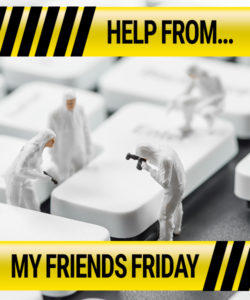 Happy belated 2024, Readers and Friends. So much happened at the end of 2023, it’s taken me a while to delve back into writing. But I’m back with the first blog of the year by friend and author Sheila Lowe. I don’t need to expound why I believe cursive is important to brain development. Sheila has the expertise and knowledge to surpass my opinions by far. She also provides a link to a free peer-review research paper with countless studies on the subject. Further, she’s announcing a contest for grade schoolers! Please welcome Forensic Handwriting Expert Sheila Lowe. ~ Donnell
Happy belated 2024, Readers and Friends. So much happened at the end of 2023, it’s taken me a while to delve back into writing. But I’m back with the first blog of the year by friend and author Sheila Lowe. I don’t need to expound why I believe cursive is important to brain development. Sheila has the expertise and knowledge to surpass my opinions by far. She also provides a link to a free peer-review research paper with countless studies on the subject. Further, she’s announcing a contest for grade schoolers! Please welcome Forensic Handwriting Expert Sheila Lowe. ~ Donnell
Cursive is Cool — and there’s a contest to prove it.
by Sheila Lowe

Author Sheila Lowe
In 1982 or so, the Writing Instrument Manufacturer’s Association declared January 23rd National Handwriting Day. It started as a self-serving event to boost sales for their members—pen and ink companies—but the American Handwriting Analysis Foundation quickly latched on and has used this date ever since to promote interest in handwriting, and specifically handwriting analysis (understanding personality through handwriting).
Why that date? January 23rd is the birthday of John Hancock. Remember that big, bold signature on the bottom of the Declaration of Independence? He is said to have written it that way so King George could read it without his spectacles. Thus, when you are going to sign something, you “put your John Hancock on the dotted line.” I’m probably dating myself, as these days, not everyone knows how to sign their name.
That statement may shock you. Or perhaps it won’t if you’ve noticed that your children or grandchildren couldn’t read your handwritten notes or birthday cards. The fact is, most schools stopped teaching children how to write in cursive in 2009 when the Common Core Curriculum went into effect and that requirement was omitted. Since then, the deplorable shortsightedness of that action has become clear in increased learning disorders and illiteracy, and behavioral problems.
At virtually every presentation I’ve made in the past ten years, the question has been asked, “why don’t they teach cursive anymore?” I gave you the answer above, but now I’ll share some encouraging news. When I became president of The American Handwriting Analysis Foundation (AHAF) I learned about the cursed cursive situation from members who were involved in education. We immediately formed the Campaign for Cursive and began writing letters to legislators, speaking to various groups, and generally making a lot of noise about why cursive needs to stay in schools in the digital age.
I could write a very lengthy article about the tremendous amount of time and effort that went into re-educating the educators, but I promise not to.
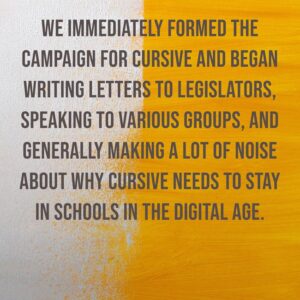 We discovered that researchers such as Karin Harmon James and many others have published studies about the beneficial effects of handwriting on the developing brain. AHAF’s research chair, Dr. Jane Yank, began compiling those studies, and wrote a white paper that cites more than 80 peer-reviewed research studies. That paper, available in seven languages, can be downloaded for free. But wait, there’s more…Dr. Yank continued reviewing new studies as they came out. They came so fast and furious, she had a hard time keeping up. Finally, she had to draw a line and we published an update, which you are encouraged to download at no charge here.
We discovered that researchers such as Karin Harmon James and many others have published studies about the beneficial effects of handwriting on the developing brain. AHAF’s research chair, Dr. Jane Yank, began compiling those studies, and wrote a white paper that cites more than 80 peer-reviewed research studies. That paper, available in seven languages, can be downloaded for free. But wait, there’s more…Dr. Yank continued reviewing new studies as they came out. They came so fast and furious, she had a hard time keeping up. Finally, she had to draw a line and we published an update, which you are encouraged to download at no charge here.
At my last count, at least 27 states had seen the light and returned cursive training to the curriculum. A big challenge is getting the younger teachers, who may not have learned this important skill themselves, to follow through and teach it. Now that Governor Newsom of California recently signed a law into effect, we hope the rest of the states will follow. Several have legislation pending.
For those who think we don’t need handwriting because we use keyboards, I hope they will consider this: throughout history, those who could read and write were on a higher strata of society. It continues to be important to be able to read our source documents—like the Declaration of Independence (or in my case, as I’m from England, the Magna Carta). You might not read such historical or other documents more than once in your life, but if you can’t read them—like the children today who cannot read cursive—how can you know you are being told the truth?
Teachers have found that behavior is improved in children who learn cursive. It helps the developing young brain with impulse control and also with fine motor skills. Kids are constantly bombarded with images of various kinds—videogames, TV, etc. Their brains need a calm space to settle down. Using cursive helps the young writer slow down and concentrate on what they are writing, which improves information retention. Besides all that, children who learn cursive have an easier time with spelling and grammar.
Some anti-cursive people complain that those loops and swirls take too long in this age where everything needs to be done quickly. That’s something AHAF agrees with. There are excellent training methods that have streamlined and simplified handwriting to its essentials, including CursiveLogic and NewAmericanCursive.
To be clear, I do not decry the use of keyboards—I’m using one right now to write this post, and it seems that most of my 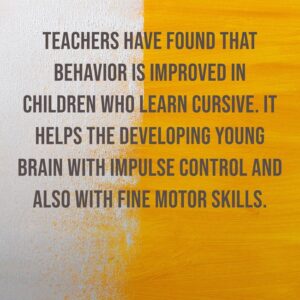 life is spent with my fingers on the keys. Technology is vital to our modern way of life. But that doesn’t mean we should throw the baby out with the bathwater (did your grandmother used to say that, too?). Cursive continues to have an important place in the curriculum. If a child doesn’t want to continue using it as they grow, that’s up to them. Once learned, the benefits to the brain remain. Few people continue to write as they were taught, and that’s a good thing—your handwriting reflects your individuality. And I’ve written a bunch of nonfiction books about that.
life is spent with my fingers on the keys. Technology is vital to our modern way of life. But that doesn’t mean we should throw the baby out with the bathwater (did your grandmother used to say that, too?). Cursive continues to have an important place in the curriculum. If a child doesn’t want to continue using it as they grow, that’s up to them. Once learned, the benefits to the brain remain. Few people continue to write as they were taught, and that’s a good thing—your handwriting reflects your individuality. And I’ve written a bunch of nonfiction books about that.
I’ll leave you with this invitation: the AHAF Campaign for Cursive sponsors the annual Cursive is Cool contest. Any grade school age child is welcome to enter in the US or Canada. There is no cost. Clink this link, which will show you how to enter. And be sure to watch the short, fun video made for our site by some previous contest winners.
 About the Author’s Memoir: After years of writing nonfiction about handwriting psychology and mystery fiction, I tackled a memoir. This book details my spiritual path after the murder of my daughter, from a strict religious background that allowed for no belief in an Afterlife, to the freedom of understanding that there is no death, only life after earth.
About the Author’s Memoir: After years of writing nonfiction about handwriting psychology and mystery fiction, I tackled a memoir. This book details my spiritual path after the murder of my daughter, from a strict religious background that allowed for no belief in an Afterlife, to the freedom of understanding that there is no death, only life after earth.
About the Author: Sheila Lowe is the award-winning author of the Forensic Handwriting suspense series, the Beyond the Veil paranormal suspense series, and six nonfiction books about handwriting psychology, plus her memoir, Growing From the Ashes, which details her spiritual journey following the murder of her daughter. A former president of the American Handwriting Analysis Foundation and Ethics Chair of the Scientific Association of Forensic Examiners, Sheila has taught at the University of California Riverside campus in the Crime Scene Investigation certificate program. Her Handwriting Analyzer software has been used by businesses and individuals around the world since 1997. www.sheilalowebooks.com


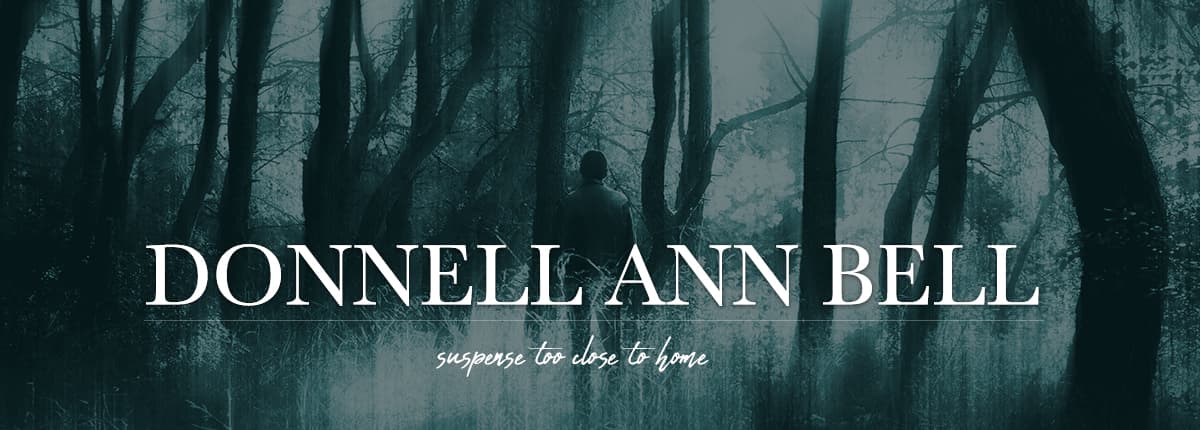
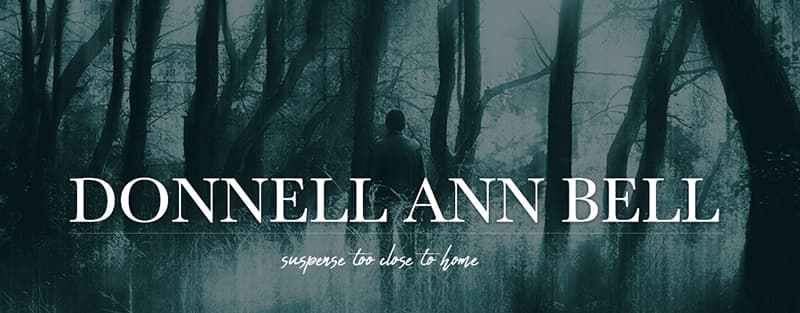







Handwriting analysis was one of my favorite geeky pastimes when I was a teen. Another was reading old journals and correspondences from my ancestors.
I’m thrilled to learn cursive is making a comeback!
What an adventure to read handwritten notes from long ago, Annette. Imagine find them and NOT being able to read them. Thanks for commenting.
Great post. Much to ponder. We need to talk more about the benefits of cursive for the developing brain. The notion among educators that it takes too long is just silly. It’s not just communication and comprehension but also art.
Katherine, I’m such a supporter of cursive for two-fold reasons. I loved writing in cursive, then later when I took Greg shorthand. I still write my novels in shorthand. I tell myself I’m exercising different parts of my brain when using either. Of course, I also used the stenograph machine for court reporting and that’s a different format altogether. Thank you for commenting on this issue near and dear to me.
Thanks for a fascinating post! (And thanks again, Shelia, for your help with handwriting analysis in Gone to Darkness.) I’m sorry to learn about your daughter, and I look forward to reading your memoir.
Thank you, Barbara. Some people have said they thought the memoir would be too difficult a read, but many who have read it said it made them feel good–I hope you are one of them.
What a fascinating post, Sheila. Thank you for sharing.
Thank you for championing cursive.It’s amazing how many people approaching 50 don’t read cursive. So much will disappear when people can’t.
An interesting example. A few years ago I took a day-long course in bourbon history. A Kentucky museum that collects mash bills (recipes) from historic distillers had trouble finding researchers who could read the mash bills written in cursive.
What a great post. Cursive is a vital skill. I had to teach my kids myself since they’d taken it out of the school curriculum but I’m glad they are putting it back in a lot of places.
Good for you, teaching them!
Sheila, I’ve been contacted by a number of teachers today who are giving you verbal high fives. I hope you felt their admiration.
I’m thrilled to hear it!
This was wonderful, Sheila. There is also something almost spiritual about writing in cursive. Maybe that’s the slowing down and focusing piece you described as part of the process.
Im a big cursive person-lots of loops and boats. Some say my writing is nice. Others say they cant read it. Relatives didnt learn it and their adult writing is childlike. So bring it back!
Amen, Vicki 😉 We worked so hard at penmanship. As many have said, it’s an art, which activates the brain.
Thank you for this wonderful post, Sheila, and thanks, Donnell, for hosting. Every morning of my elementary school days started with cursive practice. I’ve never been sorry for that and enjoy to this day being able to recognize the similarities between my penmanship and my brother’s and sister’s, as well as that of my old school mates.
As a newly retired teacher of 25 years, I am on team cursive ! Studies have shown that learning cursive improves retention and comprehension. It also gives students a better idea of how words work in combination. My kiddos loved learning cursive. —Jackie Rigg
Thanks, Sheila, for this eye-opening post on cursive writing. I’m not surprised that New Mexico doesn’t require teaching public school students how to write cursive, but that needs changing, in my opinion. You make a strong case for the benefits of cursive writing on the development of young brains.
Bailey Herrington